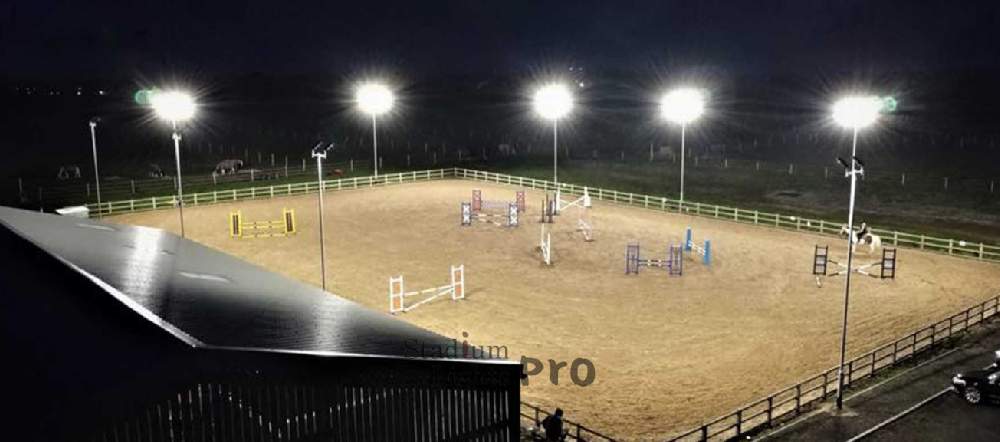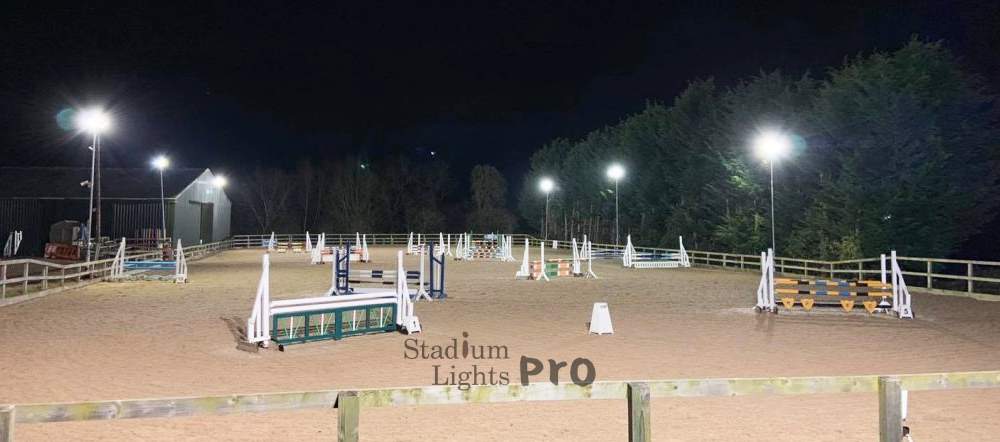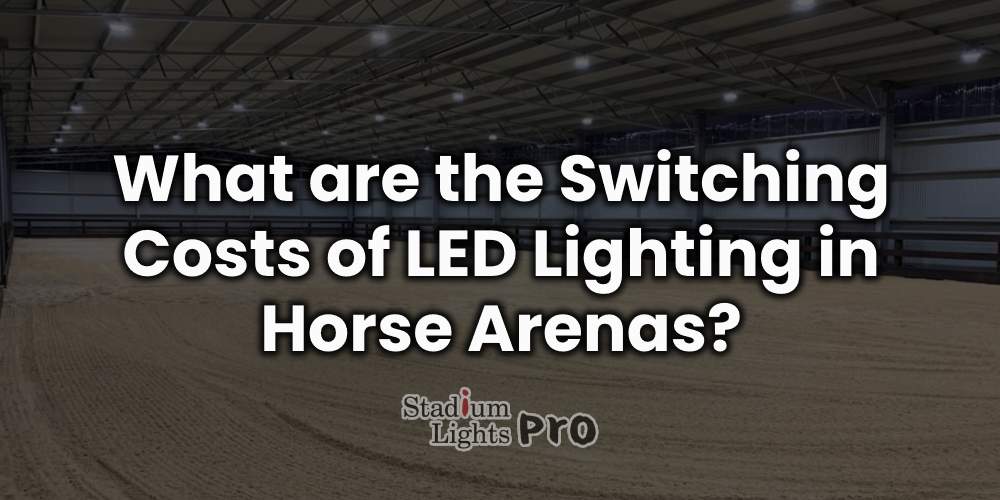The transition from traditional lighting to LED lighting in horse arenas represents a significant shift in both technology and investment. Horse arenas, whether used for training, competitions, or leisure, require specialized lighting to ensure safety, visibility, and optimal performance. As arenas consider switching to LED lighting, understanding the associated costs becomes crucial. These costs, often termed “switching costs,” encompass not only the financial investment but also the practical implications of the transition. This article explores the switching costs involved in upgrading horse arenas to LED lighting, including initial capital outlay, operational impacts, and long-term benefits.
Table of Contents
ToggleInitial Investment Costs
When considering an upgrade to LED lighting in horse arenas, the initial investment costs are a critical factor that must be carefully evaluated. This financial commitment involves several elements, including the cost of LED fixtures, installation expenses, and potential modifications to the existing infrastructure. A detailed understanding of these costs can help arena operators make informed decisions about the transition to LED lighting.
Cost of LED Fixtures
The cost of LED fixtures is a primary component of the initial investment. Compared to traditional lighting technologies such as halogen or metal halide bulbs, LED lights typically come with a higher upfront price. This elevated cost is due to several factors inherent to LED technology, including advanced components and extended lifespan.
Advanced Technology
LED fixtures are engineered with sophisticated technology that allows them to operate more efficiently and last significantly longer than their traditional counterparts. This technology includes high-quality LED chips, advanced thermal management systems, and integrated drivers, all of which contribute to the overall cost. The superior build quality and the precision involved in manufacturing LED fixtures mean they often come at a premium compared to traditional lighting solutions.
High-Output Fixtures
For large horse arenas, high-output LED fixtures are frequently required to ensure adequate illumination across the expansive area. These fixtures are designed to deliver bright, uniform light over a wide space, meeting specific performance standards essential for visibility and safety. High-output LEDs can be particularly costly due to their robust design and powerful performance capabilities. The initial cost per fixture for these models is substantial, reflecting their enhanced functionality and durability.
Specialized Lighting Needs
In addition to standard LED fixtures, arenas may need to invest in specialized lighting solutions tailored for specific functions or areas within the arena. For example, fixtures that focus light on performance areas, or those that can be adjusted to accommodate varying lighting requirements, may incur additional costs. The range of LED options available, from general-purpose to high-intensity and specialty fixtures, influences the total expenditure. Each type of fixture serves a unique purpose, and the need for customization can further increase costs.

Installation Expenses
The installation of LED lighting systems in horse arenas involves additional expenses beyond the cost of the fixtures themselves. Proper installation is crucial to ensuring the system’s effectiveness and longevity, which often necessitates professional services.
Professional Installation
The complexity of installing LED lighting systems means that hiring qualified electricians or specialized contractors is usually necessary. These professionals are responsible for ensuring that the lights are installed correctly, meeting safety standards and optimizing performance. The installation process involves several critical tasks, including mounting fixtures at appropriate heights and angles, configuring electrical connections, and integrating the new lighting system with existing controls.
Labor and Time
The cost of professional installation can vary significantly based on the size of the arena and the complexity of the lighting needs. Larger arenas or those with complex lighting requirements may require more extensive labor and time, contributing to higher installation costs. The need for precision in positioning and aligning the fixtures, as well as the potential for adjustments to the electrical setup, can add to the overall expense.
Existing Infrastructure Compatibility
If the existing lighting infrastructure is outdated or incompatible with LED technology, additional work may be required to retrofit or upgrade the system. This can involve replacing or modifying components such as mounts, brackets, and electrical fittings to ensure compatibility with the new LED fixtures. The complexity of retrofitting an existing system can significantly impact installation costs, particularly if extensive changes are needed.
Wiring Upgrades
LED fixtures have different electrical requirements compared to traditional lighting technologies. They may operate at different voltage levels or require specific power configurations that older wiring systems cannot support. Upgrading the wiring to meet these requirements involves significant costs, including both labor and materials. This process ensures that the electrical system can safely and effectively support the new LED fixtures.
Circuit Breaker and Dimmer Control Upgrades
Existing circuit breakers and dimmer controls may also need to be updated to handle the new LED fixtures. Traditional circuit breakers designed for older lighting technologies may not be suitable for LED systems, which can have unique electrical characteristics and load capacities. Similarly, dimmer controls used with traditional bulbs may not be compatible with LEDs, necessitating the installation of new controls or modification of existing ones. These upgrades ensure that the electrical system can manage the demands of the LED lighting while maintaining safety and functionality.
Retrofitting and Compatibility Issues
In cases where the existing lighting system is particularly outdated or incompatible with LED technology, extensive retrofitting may be required. This could involve replacing or adjusting fixtures, mounts, and electrical components to ensure compatibility with the new LED system. Retrofitting can be a complex and costly process, particularly if significant changes are needed to the infrastructure. The cost and complexity of these modifications highlight the importance of thorough planning and assessment before proceeding with the upgrade.
| Cost Component | Description | Estimated Price Range (USD) |
|---|---|---|
| LED Fixtures | Cost per fixture for standard and high-output models. | $150 – $1,500 per fixture |
| High-Output Fixtures | High-intensity LED fixtures for large areas. | $500 – $2,500 per fixture |
| Specialized LED Fixtures | Fixtures designed for specific functions (e.g., performance areas). | $300 – $1,000 per fixture |
| Installation Labor | Professional services for installing LED fixtures. | $75 – $150 per hour |
| Installation Time | Total hours required for installation (varies by arena size). | $1,000 – $5,000 |
| Mounting Hardware | Costs for additional mounts and brackets. | $50 – $300 per unit |
| Electrical Upgrades | Modifications to wiring, circuit breakers, and dimmer controls. | $500 – $2,500 |
| Specialized Equipment | Tools and devices for precise fixture alignment. | $200 – $1,000 |
| Adjustment and Calibration | Time and labor for fine-tuning the lighting system. | $500 – $2,000 |
| Professional Services | Costs for hiring electricians or contractors. | $1,000 – $3,000 |
Installation and Setup Costs
The installation and setup of LED lighting in horse arenas can be a significant component of the overall switching costs. Unlike traditional lighting systems, which often have a more straightforward installation process, LED lighting requires careful planning and execution. This section explores the various aspects of installation and setup costs associated with transitioning to LED lighting.
Strategic Planning for Optimal Illumination
Installing LED lighting in a horse arena involves more than just replacing old bulbs with new ones. The layout and positioning of LED fixtures must be carefully planned to achieve uniform illumination across the entire arena. This strategic planning ensures that all areas are adequately lit, minimizing shadows and providing consistent lighting for both safety and performance.
Layout and Positioning
The effective placement of LED fixtures is crucial to achieving the desired lighting outcome. Unlike traditional lighting systems that may have less stringent requirements, LED lighting often demands precise positioning to ensure optimal performance. The layout might involve repositioning existing fixtures or installing new mounting hardware to support the LED lights. This meticulous planning helps to maximize light distribution and avoid potential issues such as dark spots or uneven lighting.
Integration with Existing Infrastructure
In many cases, the installation of LED lighting may require modifications to the existing infrastructure of the arena. This could involve adjusting or upgrading mounts, brackets, and other support structures to accommodate the new LED fixtures. Ensuring that the new lighting system integrates seamlessly with the existing setup can add to the overall installation costs.
Installation Requirements
Mounting Heights and Angles
LED fixtures often have specific installation requirements that must be adhered to for optimal performance. These requirements can include precise mounting heights and angles, which are essential for achieving the correct light distribution and intensity. Meeting these specifications might necessitate additional labor or adjustments to existing structures, such as adjusting ceiling heights or installing new mounting hardware.
Specialized Equipment
The installation process for LED lighting may also require specialized equipment to ensure proper alignment and placement. For example, tools and devices that measure and adjust the angle of fixtures or ensure accurate mounting heights can add to the overall cost. This equipment ensures that the LED lights are installed correctly and perform at their best.
Electrical Requirements
LED fixtures may have different electrical requirements compared to traditional lighting systems. This can include specific voltage levels, power configurations, or wiring needs. The installation process must address these requirements, which may involve updating or modifying electrical connections, circuit breakers, or dimmer controls. Meeting these electrical requirements ensures that the LED system operates safely and efficiently.
Professional Installation Services
The complexity of installing LED lighting systems often necessitates the involvement of professional electricians or specialized contractors. These professionals bring expertise to the installation process, ensuring that the LED fixtures are mounted correctly, wired properly, and integrated with existing controls. The cost of hiring these professionals can be significant, particularly for large arenas or complex installations.
Adjustment and Calibration
Once the LED fixtures are installed, additional work may be required to adjust and calibrate the system. This includes fine-tuning the position and angle of each fixture, ensuring that the lighting is evenly distributed and meets the required performance standards. The time and effort involved in this adjustment process add to the overall installation costs.

Maintenance and Operational Costs
While LED lighting systems offer substantial savings in terms of energy efficiency and longevity, there are ongoing maintenance and operational costs to consider.
One of the key advantages of LED lights is their extended lifespan compared to traditional lighting options. LEDs can last up to 50,000 hours or more, significantly reducing the frequency of bulb replacements. This longevity translates into lower maintenance costs over time, as fewer replacements and repairs are needed.
However, it’s important to note that the initial maintenance setup might involve additional costs. For instance, the installation of LED lighting might require the purchase of specialized tools or equipment for maintenance and repair. Additionally, while LEDs generally require less frequent replacement, any issues with the fixtures or associated components may necessitate professional servicing, which can add to the operational expenses.
Energy Efficiency and Long-Term Savings
One of the most compelling reasons to switch to LED lighting is the significant reduction in energy consumption. LEDs are highly efficient, converting a larger portion of electrical energy into light compared to traditional lighting systems. This efficiency results in lower energy bills, which can offset the initial investment over time.
In horse arenas, where lighting is often required for extended periods, the energy savings can be substantial. LED lights consume less power, leading to reduced electricity costs and a lower environmental footprint. Additionally, the reduced heat output of LEDs minimizes the load on air conditioning systems, contributing to further cost savings.
Environmental Impact and Sustainability
Switching to LED lighting also has notable environmental benefits, which, while not always directly reflected in financial costs, can influence long-term sustainability. LEDs are free from hazardous materials such as mercury, which is present in some traditional lighting systems. This eliminates the need for special disposal procedures and reduces the environmental impact associated with lighting waste.
Moreover, the energy efficiency of LEDs contributes to a lower carbon footprint. By reducing energy consumption, horse arenas can help mitigate their environmental impact and support sustainability goals. These benefits align with broader efforts to promote eco-friendly practices and can enhance the arena’s reputation as a responsible and forward-thinking facility.
Operational Disruptions During Transition
The process of switching to LED lighting may also involve operational disruptions, which can be considered a form of switching cost. During the installation phase, arenas may need to temporarily halt activities or adjust schedules to accommodate the lighting upgrade. This could affect training sessions, events, or other activities, leading to potential revenue losses or inconvenience for users.
Additionally, the transition period might involve a learning curve as staff and users adjust to the new lighting system. Training may be required to ensure proper use and maintenance of the LED fixtures, which could add to the overall cost of switching.
Considerations for Future Upgrades
As technology continues to evolve, future upgrades and advancements in LED lighting may influence the overall switching costs. While the initial investment in LED technology may be higher, ongoing innovations could lead to further cost reductions or improvements in performance.
For instance, advancements in smart lighting technology, such as automated controls or integration with building management systems, could enhance the functionality and efficiency of LED lighting in horse arenas. These future enhancements might require additional investment but could offer greater long-term benefits in terms of energy savings and operational efficiency.
Conclusion
The switching costs of LED lighting in horse arenas encompass a range of factors, from initial capital expenditure and installation expenses to long-term operational savings and environmental benefits. While the upfront investment and potential disruptions during the transition are significant considerations, the advantages of LED lighting—such as energy efficiency, reduced maintenance, and sustainability—offer substantial long-term value.
As horse arenas weigh the decision to upgrade to LED lighting, it’s essential to evaluate both the immediate costs and the future benefits. By understanding the full scope of switching costs, arenas can make informed decisions that enhance their lighting systems while supporting operational efficiency and sustainability goals. The transition to LED lighting represents not only a technological advancement but also a commitment to improving the overall experience for horses and their riders while contributing to a greener future.

